DepthReading
Ancient port reveals its secrets
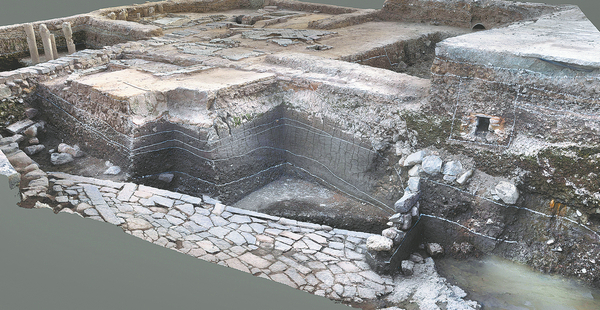
Finds at best site of its kind in China fill in gaps in record of Maritime Silk Road, Xu Xiaodan and Wang Ru report in Wenzhou, Zhejiang province.
A panoramic scroll attributed to Yuan Dynasty (1271-1368) court painter Wang Zhenpeng, or his disciple, depicts life in the bustling port town of Wenzhou, which lies on the Oujiang River in Zhejiang province.
Wenzhou was Wang's home, and his scroll shows its busy port, with cargo vessels coming and going, and a variety of people engaged in trade.
Through existing poems and paintings, it has long been possible to trace the past prosperity of ancient Wenzhou port during the Song (960-1279) and Yuan periods, but now a more accurate portrait of that moment in history is emerging from the recent archaeological discovery of the ruins of the city's ancient port of Shuomen.
The discovery was listed as one of the top 10 archaeological discoveries of 2022, as announced by the National Cultural Heritage Administration in March.
Shuomen was uncovered during construction in 2021, and the archaeological excavation, which is still ongoing, began immediately after.
The site, which covers about 5,000 square meters, is roughly divided into three parts, namely the wengcheng (the name for a defensive enclosure outside a city gate) area in the west, the water gate area in the east, and the port area near the Oujiang River between the two.
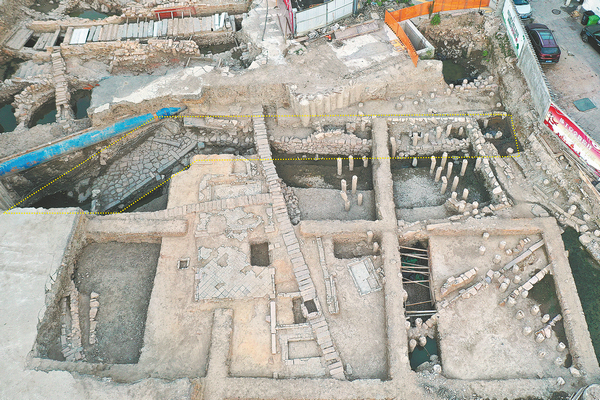
Place of poets
Wenzhou once had intersecting waterways like Venice, and boats were the primary means of transportation. It was built in 323 during the Eastern Jin Dynasty (317-420), of which the layout was said designed by the geomancer Guo Pu (276-324).
The city had several city and water gates. According to Wu Xianjun, a researcher with the Wenzhou Institute of Cultural Relics and Archaeology, the water gate site currently being excavated is roughly where one was located to the northeast of the city.
It was used to control the flow of water through the city, and locks to do just that have been found, but the gate itself still has not been discovered. Archaeologists have unearthed a sloping wharf, which would allow for the use of carts to transport goods, according to Wu.
The wengcheng area in the west, on the other hand, was the location of one of the city gates, known as the Shuomen Gate.
Remains of two wengcheng built in different periods of time have been found in the area. The earlier one, dating to the Song and Yuan dynasties, was shaped like an arc. Wu says it stood more than 9 meters when being built.
The later one, dating from the Ming (1368-1644) and Qing (1644-1911) dynasties, was rectangular.
On the Shuomen Gate, a towering building was added for a panoramic view of the river bank.
Wu says the building used to be visited by Xie Lingyun, a poet and government official from the Southern and Northern Dynasties (420-581) for a break between duties.
Famous for his landscape poetry, Xie wrote many such poems while he was stationed in Wenzhou, adding to the area's cultural prestige, says Wu.
He adds that in commemoration, people named the building after the poet, calling it the Xiegong Building. Neither the gate nor the building exists today, but a photo taken in 1877 shows how the structure once looked.
The river port site extends for 340 meters from east to west, and has docks of various kinds and sizes, stilt houses, wells and shipwrecks, and it forms the most complete ancient port from the Song and Yuan periods unearthed to date, says Liang Yanhua, director of the Wenzhou Institute of Cultural Relics and Archaeology.
Historical literature records that to the north of the Shuomen Gate there was a Zhenjiang Pavilion, and beside the pavilion, there were courier stations for receiving officials or foreign envoys. Excavations have unearthed the remains of wooden trestles, which are believed to have been connected to the pavilion in the past, and so some of the stilt houses found nearby may have been used as courier stations, says Liang.
Wu says that according to the records, low-ranking officials, who were responsible for receiving guests, lived such busy lives that they could barely find time to rest.
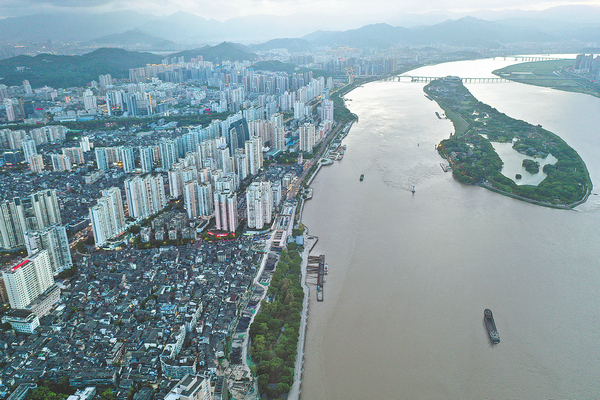
Export hub of porcelain
Three shipwrecks have also been found. The No 1 shipwreck dates to the Southern Song Dynasty (1127-1279), and has been removed from the site for better study and preservation. The No 2 shipwreck, which dates to no later than the Northern Song Dynasty (960-1127), remains mostly buried, and only parts of it have been exposed. And the third one, smaller and more damaged, is kept underground with some parts exposed as well.
According to Liang, the No 1 shipwreck is of a fuchuan, a type of boat also known as a Fujian vessel, one of the four types of ancient wooden Chinese ships, and which was used as a cargo vessel from the Song Dynasty. The wreck contains a coin and bottles from the period.
"The ship was probably abandoned, and had no cargo," says Wu.
"It was a medium- to small-sized ship at the time, only about 20 meters in length, and could hold between 100 and 200 metric tons of cargo. During the Song Dynasty, many freighters were 50 to 60 meters long and had capacities of 700 to 800 tons."
He adds that during the Song Dynasty, Wenzhou was one of the most developed shipbuilding centers in China. Historical literature shows that during the late Northern Song period, Wenzhou built 600 ships for the government every year, the most built anywhere in China at the time.
Piles of porcelain items and pieces, lacquerware, glazed artifacts, shells and plant specimens dating from the Northern Song to the early 20th century have been unearthed, with Song and Yuan relics making up the largest proportion.
Around 2,000 complete porcelain items have also been found, as well as some 10 tons of fragments, 90 percent of which were produced at the Longquan kiln in Longquan, Zhejiang.
According to Liang, Longquan celadons accounted for a large part of the porcelain sold overseas from the Southern Song Dynasty until the middle of the Ming Dynasty, and is regarded as the first Chinese commodity to have global appeal before the Age of Exploration.
"The discovery shows that Wenzhou was a major distribution center, as well as a starting point for the transportation of Longquan celadons to other countries during the Song Dynasty," says Liang.
Wu adds that Longquan lies on the upper reaches of the Oujiang River, and Wenzhou is on the lower reaches, and so transportation by river was less costly that by road. As a result, a lot of Longquan celadons were shipped to Wenzhou, and then loaded onto ships bound for abroad.
He also mentions Ningbo in Zhejiang, another important node on the ancient Maritime Silk Road, as also being an important port for shipping Longquan celadons overseas during the Yuan Dynasty, but says that Wenzhou was involved in the trade earlier.
Besides ceramics, lacquerware was also a notable Wenzhou product. During the Song Dynasty, the city was home to a great number of workshops producing lacquerware, which made Wenzhou lacquerware a recognizable name.
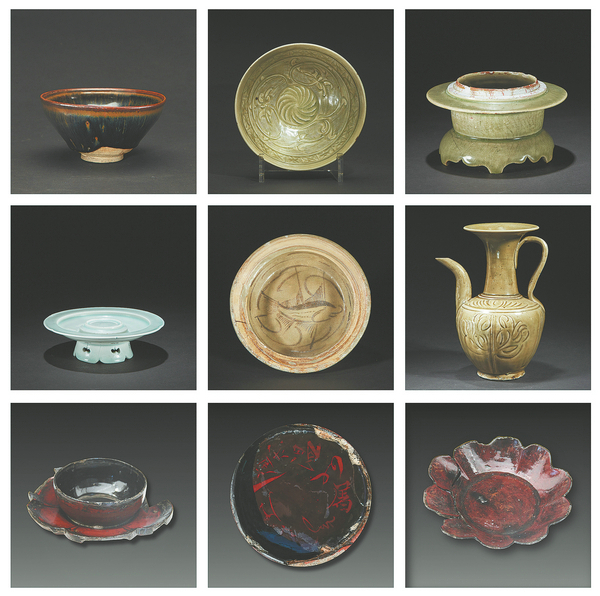
On the busy streets of Bianjing (now Kaifeng, Henan province), the imperial city of the Northern Song Dynasty, and Lin'an (now Hangzhou, Zhejiang), the imperial city of the Southern Song Dynasty, many shops sold Wenzhou lacquerware, says Liang. Wu infers from this that the success of lacquerware was related to the developed level of shipbuilding at the time.
"There are many links between ship-making and lacquerware making. For example, the wooden offcuts from ship building could be used to make lacquerware, and the ships needed to be covered in hard, black varnish for fear of their wood rotting."
The artifacts were clearly made for trade, says Wu, as they show no trace of having been used. Moreover, most of the pieces found were broken, and losses perhaps incurred during storage or transportation.
Nine different kinds of docks have been unearthed. Some are believed to have belonged to the government, while others were probably for private use. The No 3 dock, which dates to the Southern Song period and which was rebuilt several times, is the most complete of them all.
"Following changes to the river bank, the dock was made longer and narrower to adapt to its new environment," says Liang.
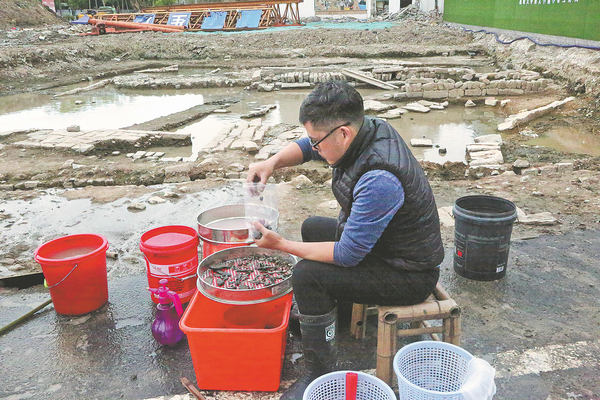
Wu says that Song and Yuan governments encouraged maritime trade. According to historical records, when cargo ships docked in Wenzhou, crew were welcomed by local officials responsible for maritime trade. The owners were required to give part of their cargo to the government in duties before they could sell their goods or buy other goods in the city.
"What they brought to sell in Wenzhou was usually luxuries like spices, medicines, pearls and jewels. Of course they never returned with an empty ship, and bought porcelain, silk and tea in Wenzhou to sell elsewhere," says Wu, adding that the ships usually remained in Wenzhou for weeks at a time in order to sell all their goods.
When foreign traders were ready to leave, a send-off ceremony was often held by the local government, which included rituals to the god of the sea to pray for the ship's safety.
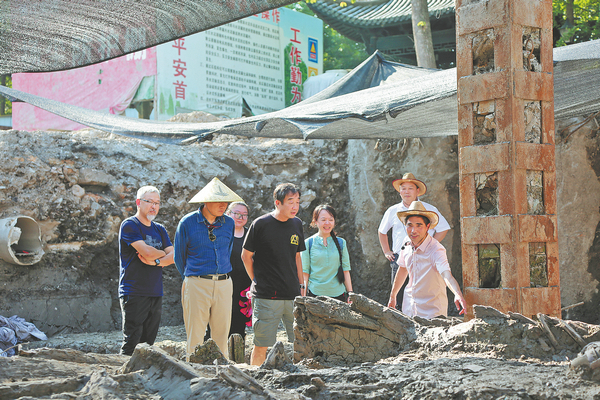
"The captains usually chose a good time to leave, particularly favoring days when the wind was blowing in the right direction," says Wu.
Although Wenzhou maritime trade experienced its heyday during the Song and Yuan periods, making it an important station on the ancient Maritime Silk Road with the establishment of professional institutes governing maritime trade, it actually has a much longer history.
According to Liang, early in the Warring States Period (475-221 BC), present-day Wenzhou was one of nine ports in China.
Before the discovery of Wenzhou's ancient port, sites have been found in other cities, but none of them compare to Shuomen.
Liu Qingzhu, a researcher at the Chinese Academy of Social Sciences and dean of the history school at Zhengzhou University, tells Xinhua that this site is the most complete of its kind in China. Its relics and artifacts, which can be accurately dated, provide solid evidence that the Maritime Silk Road thrived during the Song and Yuan dynasties.
"As of present, whether it is cities already listed as World Heritage site, like Quanzhou (Fujian province) and Macao, or their counterparts applying for global recognition as port cities on the Maritime Silk Road, like Guangzhou, Ningbo (Zhejiang), Dengzhou (today in Penglai, Shandong province) and Yangzhou (Jiangsu province), archaeological evidence is lacking," says Liang.
"The archaeological work at the Shuomen site fills in this blank, and can be seen as part of the precious heritage of the history of maritime civilization," he adds.
Category: English
DepthReading
Key words:
